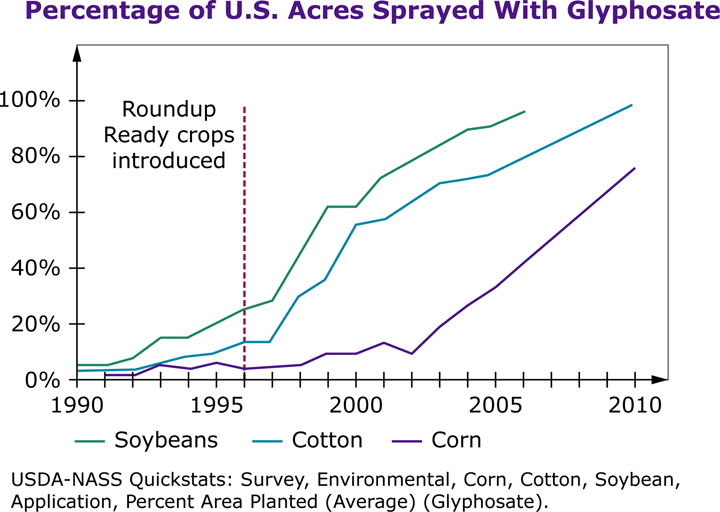Plant Reproduction
Applying Plant Reproduction
Most of the food we eat comes from organisms that humans have modified in some way. The plants that we consume today often bear very little resemblance to their ancestors; for example, ancient corn contained fewer and smaller kernels. In the past, plants were altered by selective breeding. Plants having desirable traits were bred with each other, amplifying the desirable trait through multiple generations. Creating hybrids of two different species is also a common agricultural technique. An example of a hybrid species is the tangelo, a hybrid of a tangerine and a grapefruit.
Plant biotechnology is an extremely important field in the modern agricultural industry. However, some researchers are using the same technology to, in a manner of speaking, “go back in time.” Geneticists and plant physiologists are using gene sequencing technology and gene transfer techniques to determine the identity of ancestors of modern plants. Scientists can determine the specific gene, or genes, that conferred the desired characteristics. Additionally, scientists could identify genes that control desirable characteristics in the original plant that were lost during selective breeding.
The knowledge gained can provide new target genes for transfer into crop plants. This enables scientists to help farmers grow crops that produce more food and resist factors such as pests and drought. Scientists are currently studying the effects that gene transfer has on plants and the health of the organisms that consume them. The ultimate goal is to develop plants that will help feed the growing world population without damaging the environment.
STEM and Plant Reproduction
Genetic engineers alter genes to improve the biological potential of plants and animals. The process of genetic engineering involves isolating the genes for desirable traits and inserting them into new plants. Examples of desirable traits in a plant might include fruitglossary term (opens in a new window) that is larger, plants that use less water, or plants that are resistant to disease. Plants can be genetically altered to resist freezing temperatures or to produce fruit that has a longer shelf life. In the past, plants were altered by selective breeding or cross-pollination. Modern plant biotechnology allows for the direct transfer and insertion of desired genes from one plant into another.
Genetic engineering is the application of technology to change the genetic makeup of an organism. Genetic engineers usually work in laboratories in pharmaceutical companies, universities, or government agencies. The techniques they employ involve sophisticated manipulations of DNA and other biologically relevant molecules. The most widely used method is gene transfer, where new DNA is inserted into the cell of a new organism. Genes of interest are excised from the genome of a variety of organisms, including bacteria and plants. The gene is then placed into the genome of the plant of interest or into a virus that is used to infect the plant. The geneticist or agrobiologist then selects the plants that express the gene of interest. Because the technology includes the transfer of genes across species boundaries, it is fundamentally different from traditional methods of altering plants, such as grafting, used to obtain desired characteristics.
Plant biotechnology could allow humans to produce food more efficiently, an important consideration for a growing population. Farmers can generate higher crop yield using less space, less water, and less chemical fertilizer with some genetically modified plants. Some believe that genetic engineering of plants will be crucial for solving hunger around the world, although this is a heavily debated topic. Indeed, the potential for unknown health and environmental risks of genetically modified crops is of great concern to biologists and ecologists.
Teacher Note
This summative activity is intended to extend student thinking on the material in the lesson. The activity should be conducted as a think-pair-share to give all students the opportunity to delve into the topic and to contribute to the class.
-
<div use-dimensions="false" tinymce="true">Describe the trends in glyphosate use over time. Include in your answer the relationship to introduction of glyphosate-resistant crops.<br></div>Describe the trends in glyphosate use over time. Include in your answer the relationship to introduction of glyphosate-resistant crops.Press Space or enter key to Enter Text
-
<div use-dimensions="false" tinymce="true">If additional crops were made glyphosate resistant, what would you expect to happen to glyphosate usage?<br></div>If additional crops were made glyphosate resistant, what would you expect to happen to glyphosate usage?Press Space or enter key to Enter Text
-
<div use-dimensions="false" tinymce="true">What would explain the change in use of glyphosate for these crops?<br></div>What would explain the change in use of glyphosate for these crops?Press Space or enter key to Enter Text
-
<div use-dimensions="false" tinymce="true">Explain the health concern related to the data presented in this graph.<br></div>Explain the health concern related to the data presented in this graph.Press Space or enter key to Enter Text

